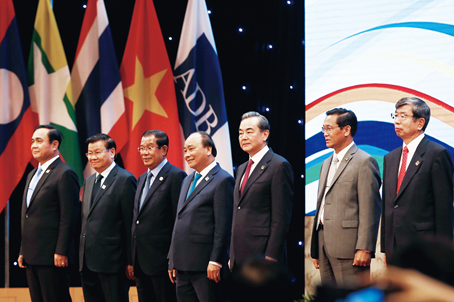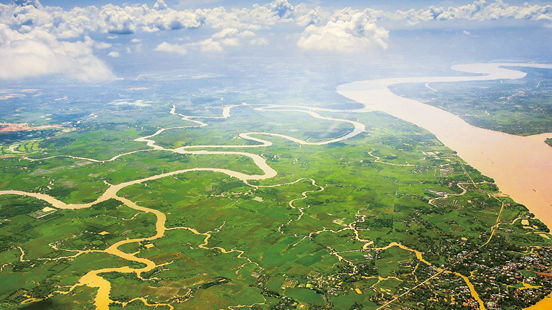

The Mekong Sub-region that consists of Cambodia, Laos, Myanmar, Thailand and Vietnam is an economically emerging and attractive market of over 230 million people with an annual growth rate of 6% to 8%, active workforce and abundant natural resources. Several development partners are actively engaging with the Mekong Sub-region through existing regional frameworks cooperation. Yet these countries work closely enough to ensure that their efforts are complementary and not duplicated. This article briefly explores the existing players and their endeavour to boost prosperity in the sub-region.
ACMECS, conceived by Thailand in 2003, is the first and most significant jigsaw in the picture. The objectives of ACMECS are to narrow economic development gap and promote sustainable growth in the Mekong sub-region. This can be done through developing infrastructure connectivity, enhancing the harmonization of rules and regulation of cross border trade and transport facilitation as well as promoting human resources development. With a view to becoming more responsive to evolving opportunities and challenges amidst the age of globalization and geopolitical changes, ACMECS, under Thailand Chairmanship in 2018, has adopted the first ACMECS Master Plan (2019-2023), focusing on multidimensional Connectivity as an effective tool to integrating the Mekong sub-region into regional and global value and supply chain.

ACMECS is also formalizing its cooperation with external partners for effective implementation of the Master Plan, through appointment of the ACMECS Development Partners. Currently, all countries that have established presence in Mekong have already joined ACMECS Development Partners and are in the process of formulating Joint Development Plan as specific guidelines for cooperation with ACMECS.
The Lower Mekong Initiative (LMI), initiated by the United States in 2009, aims to deliver equitable, sustainable and inclusive economic growth in the Mekong sub-region by cooperating under two pillars including 1) Water, Energy, Food and the Environment Nexus Pillar and 2) Human Development and Connectivity Pillar, with Gender Equality and Women’s Empowerment and Private Sector Engagement as cross-cutting issues. The implementation is illustrated by flagship projects such as the Mekong Water Data Initiative, Sustainable Infrastructure Program(SIP) as well as LMI Young Scientist Program. In 2019 when Thailand was a co-chair, the 12th Ministerial Meeting was held to commemorate its 10th anniversary under the theme “The Future of the Mekong River.”
India’s engagement with the sub-region led to the establishment of Mekong-Ganga, the first cooperation framework between countries of the Mekong and a development partner, which will celebrate its 20th anniversary in 2020. Initially this regional framework emphasises cultural and people-to-people exchanges but has matured to encompass various areas of cooperation, namely connectivity and infrastructure development through Quick Impact Projects (QlPs), the US$ 1 billion Line of Credit as well as US$ 72.5 million Development Fund offered by India for investment projects in the Mekong region. Other cooperation areas include trade, water resource management, science and technology, skill development and capacity building as well as Buddhist Tourism. An important complementarity project is the Myanmar-India-Thailand Trilateral Highway, linking South Asia to Southeast Asia and its extension to the East-West Economic Corridor (EWEC) and North-South Economic Corridor (NSEC).

Mekong-Japan cooperation was established in 2008. It is now evolving under the three pillars of the Tokyo Strategy 2018; namely (1) Vibrant and Effective Connectivity with the focus on quality infrastructure development (2) Realization of a Green Mekong by supporting projects and initiatives under “Mekong-Japan Initiative for SDGs toward 2030” adopted at the 11th Mekong Japan Summit in November 2019 and (3) People-Centered Society. It also gives importance to the promotion of alignment of Mekong-Japan Cooperation with Japan’s Free and Open Indo-Pacific, which is in line with the ASEAN Outlook on the Indo-Pacific, the 2030 Agenda for Sustainable Development and the ACMECS Master Plan (2019-2023). Thailand is ready to cooperate with Japan in co-hosting Mekong-Japan SDGs Forum to promote the exchange of experiences and best practices on environmental issues and sustainable development.
The Mekong-ROK Cooperation was set up in 201l with support from the Republic of Korea. The framework is driven by dedicated Mekong-ROK Cooperation Fund of US$ 2 million per annum to reduce development gaps between member countries and promote sustainable development of Mekong based on the three pillars of People, Prosperity and Peace, which are also the key pillars of Korea’s New Southern Policy, and seven new priority areas such as Culture and Tourism, Human Resources Development, Agriculture and Rural Development, and Infrastructure. It also promotes private sector engagement through dedicated Mekong-ROK Business Forum. The Mekong-ROK recently commemorated its 10th anniversary of the cooperation and elevated the cooperation to Summit’s level in 2019.

Mekong-Lancang cooperation (MLC) developed from Thailand’s proposal in 2012 for an initiative of sustainable development of the Mekong Sub-region, which received positive response from China and led to its formal establishment in 2015. Subsequently, China hosted the 1st Mekong-Lancang Leaders’ Meeting in March 2016 in which the Sanya Declaration was adopted, laying the foundation for MLC cooperation to be carried out through the three cooperation pillars, namely (1) political and security issues, (2) economic and sustainable development, and (3) social, cultural and people-to-people exchanges. Currently, MLC member countries are working closely on the implementation of the Five-Year Plan of Action on Mekong-Lancang Cooperation (2018-2022) to achieve concrete cooperation on the five key priority areas, namely (1) connectivity, (2) production capacity, (3) cross-border economic cooperation, (4) water resources, (5) agriculture and poverty reduction, based on the principles of consensus, equality, mutual consultation and coordination, voluntarism, common contribution and shared benefits, and respect for the United Nations Charter and international laws.
The Mekong Sub-region is apparently an interesting and exciting area even for friends from afar. Each of them might have a varying concept on development and how to achieve it, but at least they have shared goals in creating prosperity and well-being for the people. Sustainable development, connectivity and human resource development are sectors of cooperation that are given high priority. Nonetheless, one thing is clear. There is a consensus that all parties should synchronize their efforts to avoid duplication of work and to optimize the limited resources.
·Source: Inter Econ of Department of International Economic Affairs, Ministry of Foreign Affairs, the Kingdom of Thailand
桂ICP备14000177号 Copyright@2006-2013 Guangxi China-ASEAN Panorama Magazine Agency Co., Ltd. All Rights Reserved